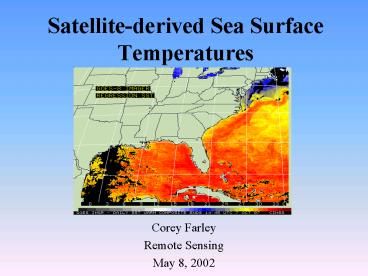Satellitederived Sea Surface Temperatures PowerPoint PPT Presentation
Title: Satellitederived Sea Surface Temperatures
1
Satellite-derived Sea Surface Temperatures
- Corey Farley
- Remote Sensing
- May 8, 2002
2
Satellites
- GOES Imager
- Continuous coverage
- High temporal resolution
- Polar Imager
- Advanced Very High Resolution Radiometer
- Global coverage
- Better data resolution that GOES
- Do not provide continuous coverage
3
GOES Imager
4
Polar ImagerAdvanced Very High Resolution
Radiometer
5
Technique for estimating SST
- An algorithm was created using channel 4 (10.7
micron) and channel 5 (12.0 micron) of the GOES
and Polar satellites. - Radiance values are obtained for both channels
and brightness temperatures are calculated. - SSTs can be calculated using brightness
temperatures and regression coefficients.
6
Weighting Functions
Referred to as the split window channels The
12.0 micron window is more sensitive to moisture
than the 10.7 micron and most of the
radiance comes from the earths surface. The 10.7
detects surface radiation and also radiation from
low clouds.
7
Limitations of using radiance measurements
- Clouds block infrared radiation, causing
errors in brightness temperature values. - The atmosphere absorbs some radiation emitted by
the surface and emits radiation back to the
surface and to the satellite. - Some solar radiation is reflected from the
surface to the satellite. - Some of these effects are wavelength dependent
and can corrected by using multiple wavelengths.
8
SST EquationsGOES Imager
- GOES-8/9 SST -6.4110 1.0260 T4 1.1900 (T4
T5) 0.2017 (T4 - T5)2 - GOES-10 SST 18.3500 0.9459 T4 0.4261 (T4 -
T5) 0.4473 (T4 - T5)2 - Screening for cloud contamination and other
factors were performed to ensure clear air
radiance values. - The coefficients are empirically determined by
comparing satellite and buoy measurements. - Accuracy Standard deviation varied from 0.6 to
0.8 K. Calculated by comparing GOES Imager and
buoy data.
9
SST EquationsPolar Imager AVHRR
Theta is the sensor zenith angle T- the
brightness temperatures at different
wavelengths A- empirically derived coefficients
10
Applications
- Since SST values can be obtained frequently, we
can monitor different phenomena. - Track El Nino and La Nina
- Ocean currents such as the Gulf Stream can be
tracked.
11
Hurricane Eduardo Track
Upwelling by Eduardo caused cooler water at the
sea surface.
12
Ocean Currents
13
QUESTIONS???

